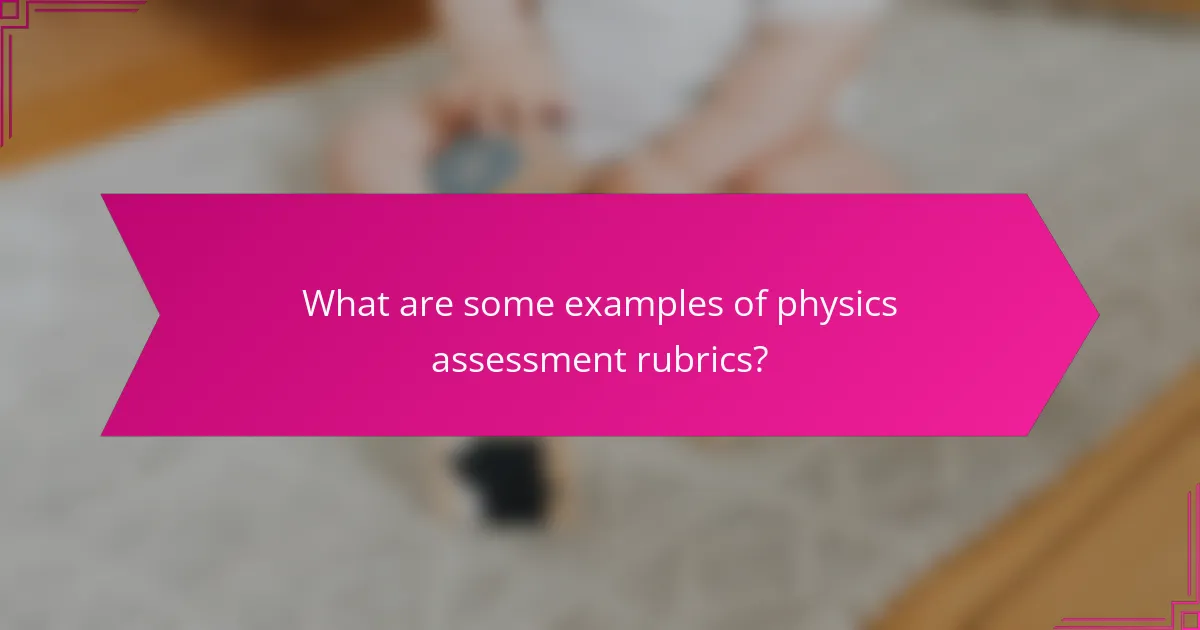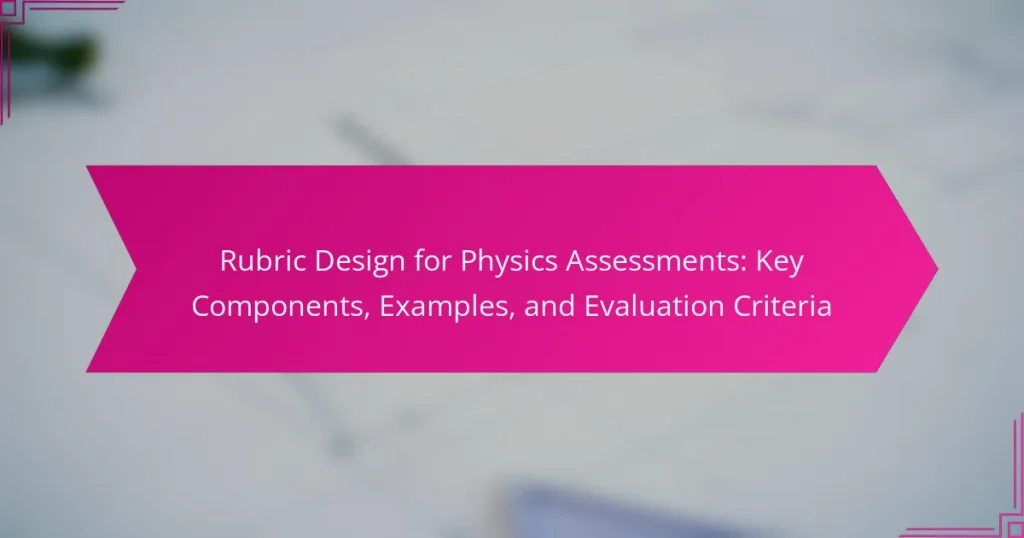Rubric design for physics assessments is a structured framework that evaluates student performance based on specific criteria and standards. This article outlines key components of effective rubrics, including clarity, relevance, consistency, and specificity, which enhance the assessment process in physics. It provides examples of various assessment rubrics, such as those for lab reports, problem-solving tasks, and presentations, detailing the evaluation criteria used to measure student understanding and performance. Additionally, the article discusses the importance of aligning rubrics with learning objectives and involving students in the creation of assessment criteria to improve engagement and outcomes.

What is Rubric Design for Physics Assessments?
Rubric design for physics assessments is a structured framework used to evaluate student performance. It outlines specific criteria and standards for grading assignments and tests in physics. A well-designed rubric includes categories such as understanding of concepts, application of knowledge, and problem-solving skills. Each category is accompanied by performance levels that describe expectations for students. This method provides clear guidance for both students and educators. Research shows that using rubrics can enhance learning outcomes by clarifying expectations. Additionally, rubrics promote consistency and objectivity in grading.
How does rubric design enhance physics assessment effectiveness?
Rubric design enhances physics assessment effectiveness by providing clear criteria for evaluation. It defines specific performance levels for student work. This clarity helps students understand expectations. Rubrics facilitate consistent grading by multiple assessors. They reduce subjectivity in evaluation. Research shows that rubrics improve student performance and self-assessment. A study by Andrade (2005) in “Educational Assessment” found that students who used rubrics performed better than those who did not. Rubric design ultimately promotes transparency and accountability in physics assessments.
What are the foundational elements of a physics assessment rubric?
The foundational elements of a physics assessment rubric include clarity, criteria, levels of performance, and feedback mechanisms. Clarity ensures that students understand the expectations. Criteria define what is being assessed, such as conceptual understanding or problem-solving skills. Levels of performance describe the range of achievement, often categorized from excellent to poor. Feedback mechanisms provide guidance for improvement. These elements collectively enhance the assessment’s effectiveness and transparency.
How does clarity in criteria impact student understanding?
Clarity in criteria significantly enhances student understanding. Clear criteria help students comprehend expectations for assignments and assessments. When students know what is required, they can focus their efforts effectively. This understanding reduces anxiety and increases their confidence in completing tasks. Research shows that well-defined criteria lead to improved performance. A study by Sadler (1989) highlights that students who understand assessment criteria achieve better learning outcomes. Thus, clarity in criteria is essential for fostering a productive learning environment.
Why is rubric design important in physics education?
Rubric design is important in physics education because it provides clear criteria for assessing student performance. It helps educators define expectations for assignments and projects. This clarity enhances student understanding of learning objectives. Additionally, well-designed rubrics promote consistency in grading. They enable educators to provide targeted feedback. Research shows that students perform better when they understand assessment criteria. A study by Andrade and Du (2005) found that students who use rubrics improve their work quality. Thus, rubric design is essential for effective learning and teaching in physics.
What advantages do well-designed rubrics provide for educators?
Well-designed rubrics provide clear evaluation criteria for educators. They enhance transparency in grading by outlining specific expectations. This clarity helps students understand what is required for success. Rubrics also promote consistency in assessment across different educators. They facilitate objective grading, reducing bias in evaluations. Additionally, well-structured rubrics can save time during the grading process. Educators can quickly reference criteria while assessing student work. Research indicates that rubrics can improve student performance by providing targeted feedback. Overall, these advantages contribute to a more effective teaching and learning environment.
How can rubrics improve student performance in physics?
Rubrics can improve student performance in physics by providing clear expectations. They outline specific criteria for assessments. This clarity helps students understand what is required for success. Rubrics also promote self-assessment and reflection. Students can identify their strengths and areas for improvement. Research shows that students who use rubrics perform better. A study by Andrade (2000) found that rubrics enhance student learning by making assessment criteria transparent. This transparency leads to higher engagement and motivation. Overall, rubrics serve as effective tools for guiding student performance in physics.

What are the key components of an effective physics assessment rubric?
An effective physics assessment rubric includes clarity, relevance, consistency, and specificity. Clarity ensures that students understand the expectations. Relevance aligns the rubric with learning objectives and standards. Consistency provides uniform criteria for grading across different assessments. Specificity offers detailed descriptions for each performance level. These components help in accurately measuring student understanding and performance in physics. Research shows that well-structured rubrics enhance student learning and assessment reliability.
What criteria should be included in a physics assessment rubric?
A physics assessment rubric should include criteria such as understanding of concepts, problem-solving skills, application of formulas, experimental design, and communication of results. Understanding of concepts evaluates the student’s grasp of fundamental physics principles. Problem-solving skills assess the ability to apply those principles to solve complex problems. Application of formulas checks the correct usage of mathematical equations in various scenarios. Experimental design measures the student’s ability to create and conduct experiments effectively. Communication of results evaluates clarity and coherence in presenting findings. These criteria ensure a comprehensive evaluation of a student’s physics knowledge and skills.
How do performance levels influence the assessment process?
Performance levels significantly influence the assessment process by providing a structured framework for evaluating student understanding. They establish clear criteria that differentiate between varying degrees of mastery. This differentiation helps educators identify specific strengths and weaknesses in student performance. For instance, a rubric may categorize performance into levels such as “exemplary,” “proficient,” “basic,” and “needs improvement.” Each category outlines specific expectations and outcomes. By using performance levels, teachers can offer targeted feedback that guides student improvement. Research shows that well-defined performance levels enhance the reliability of assessments, ensuring consistency across evaluations. Studies indicate that rubrics with clear performance levels lead to improved student learning outcomes.
What role do descriptors play in clarifying expectations?
Descriptors define the specific criteria and standards expected in assessments. They provide clear guidelines for performance levels. This clarity helps students understand what is required for success. Descriptors also enable teachers to communicate expectations effectively. Research shows that well-defined descriptors improve student performance by aligning their efforts with assessment criteria. For instance, a study by Andrade and Du (2005) found that students who received detailed descriptors performed better than those who did not. Thus, descriptors play a crucial role in clarifying expectations in educational settings.
How can rubrics be tailored for different physics topics?
Rubrics can be tailored for different physics topics by aligning criteria with specific learning objectives. Each physics topic, such as mechanics or electromagnetism, requires distinct focus areas. For mechanics, criteria might include problem-solving steps and application of Newton’s laws. In contrast, electromagnetism rubrics could emphasize understanding of electric fields and circuit analysis.
Incorporating discipline-specific terminology enhances clarity. For example, using terms like “force diagrams” in mechanics helps students understand expectations. Additionally, weightings can be adjusted based on topic complexity. More challenging topics may require a greater emphasis on conceptual understanding.
Feedback sections should also reflect the nuances of each topic. For instance, mechanics might focus on quantitative analysis, while thermodynamics could require qualitative explanations. By customizing the rubric, educators ensure assessments are relevant and targeted. This approach promotes deeper learning and better alignment with educational standards.
What specific attributes should be considered for conceptual assessments?
Specific attributes for conceptual assessments include clarity, relevance, depth of understanding, and application of concepts. Clarity ensures that questions are easily understood by students. Relevance relates to how well the assessment aligns with learning objectives. Depth of understanding assesses students’ ability to explain concepts thoroughly. Application of concepts evaluates how well students can use their knowledge in different contexts. These attributes ensure that assessments effectively measure students’ conceptual understanding in physics.
How do practical assessments differ in rubric design?
Practical assessments differ in rubric design by emphasizing hands-on skills and real-world application. Unlike traditional assessments, practical rubrics focus on observable behaviors during tasks. They often include criteria for process, collaboration, and safety. These criteria evaluate not just the final product, but also the approach taken by students. Practical assessments may require specific performance indicators, like technique proficiency or problem-solving in real-time. This design contrasts with more theoretical rubrics that prioritize written explanations and conceptual understanding. Research shows that effective practical rubrics enhance student engagement and learning outcomes in physics education.

What are some examples of physics assessment rubrics?
Examples of physics assessment rubrics include the following: a rubric for lab reports, which assesses clarity, methodology, data analysis, and conclusions. Another example is a rubric for problem-solving assessments, focusing on understanding the problem, application of concepts, calculations, and final answers. Additionally, a presentation rubric evaluates organization, content accuracy, visual aids, and delivery. These rubrics are designed to provide clear criteria for evaluating student performance in various physics tasks. They ensure consistency in grading and help students understand expectations.
What are common formats for presenting physics rubrics?
Common formats for presenting physics rubrics include grid formats, checklist formats, and narrative formats. Grid formats typically display criteria in rows and levels of performance in columns. This allows for quick visual assessment of student performance across multiple criteria. Checklist formats provide a list of criteria that can be checked off as students meet them. This format is straightforward and easy to use for both teachers and students. Narrative formats involve descriptive feedback for each criterion, offering detailed insights into student performance. Each format serves different assessment needs and enhances clarity in evaluating physics assignments.
How can sample rubrics be adapted for specific classroom needs?
Sample rubrics can be adapted for specific classroom needs by modifying criteria and performance levels. Teachers should first identify the unique learning objectives of their classroom. They can then align rubric criteria with these objectives to ensure relevance. Customizing performance levels can help reflect varying student abilities. Additionally, incorporating specific examples relevant to the subject matter enhances clarity. Feedback from students can guide further adjustments to the rubric. Regularly reviewing and revising rubrics ensures they remain effective and applicable. Research shows that tailored rubrics improve student engagement and understanding.
What are some best practices for creating physics assessment rubrics?
Best practices for creating physics assessment rubrics include clearly defining the learning objectives. This ensures that the rubric aligns with what students are expected to learn. Next, use specific criteria that address various aspects of student performance. Criteria should cover knowledge, application, and analysis of physics concepts.
Additionally, include a scoring scale that differentiates levels of performance. A common scale ranges from exemplary to needs improvement. Providing detailed descriptions for each level helps students understand expectations.
Another best practice is to involve students in the rubric development process. This can enhance their understanding and ownership of the assessment. Finally, regularly review and revise the rubric based on feedback and outcomes. This keeps the rubric relevant and effective for assessing student learning.
How can educators ensure rubrics are fair and unbiased?
Educators can ensure rubrics are fair and unbiased by using clear and objective criteria. Establishing specific performance indicators helps reduce subjectivity. Involving multiple educators in rubric development promotes diverse perspectives. Regularly reviewing and updating rubrics ensures they remain relevant and equitable. Providing training for educators on rubric use can enhance consistency in assessment. Research shows that well-defined rubrics improve grading reliability and fairness. For example, a study by Brookhart (2013) found that clear criteria lead to more consistent evaluations across different assessors.
What strategies can improve rubric usability for students?
Clear and concise rubrics enhance usability for students. Strategies include using straightforward language to define criteria. Avoid jargon to prevent confusion. Incorporate specific examples to illustrate expectations. Provide a scoring guide that outlines levels of performance clearly. Use visual aids like charts to represent criteria visually. Involve students in rubric development to foster ownership. Regularly review and update rubrics based on student feedback for continuous improvement. Research shows that clear rubrics lead to better student understanding and performance.

How can evaluation criteria be effectively implemented in physics assessments?
Evaluation criteria can be effectively implemented in physics assessments by establishing clear, measurable standards. These standards should align with learning objectives and outcomes. Involving students in the creation of these criteria can enhance their understanding and ownership of the assessment process. Additionally, using a rubric that breaks down performance levels provides transparency. Each criterion should be explicitly defined to minimize ambiguity. Regularly revising these criteria based on feedback ensures they remain relevant and effective. Research shows that well-defined evaluation criteria improve student performance and engagement in assessments.
What methods can be used to evaluate student performance using rubrics?
Rubrics can be used to evaluate student performance through several methods. First, they provide clear criteria for assessment. Each criterion is assigned specific performance levels, allowing for objective grading. Second, rubrics facilitate self-assessment and peer assessment. Students can use rubrics to evaluate their own work or that of their peers, promoting reflection. Third, they enable formative assessment. Teachers can give feedback based on rubric criteria during the learning process. Lastly, rubrics support consistency in grading across different evaluators. Studies show that using rubrics leads to improved reliability in assessment outcomes.
How do feedback and scoring align with rubric criteria?
Feedback and scoring align with rubric criteria by providing structured evaluation based on defined performance levels. Rubrics outline specific criteria that describe expectations for each level of performance. Feedback highlights areas of strength and improvement relative to these criteria. Scoring quantifies performance by assigning points based on the degree to which criteria are met. This systematic approach ensures consistency and transparency in assessment. Research shows that clear rubrics enhance student understanding of expectations (Brookhart, 2013). Therefore, effective feedback and scoring directly reflect rubric standards, fostering targeted learning outcomes.
What challenges might educators face when using rubrics in physics assessments?
Educators may face several challenges when using rubrics in physics assessments. One challenge is the difficulty in aligning rubrics with complex physics concepts. Physics often involves abstract ideas that can be hard to quantify. Another challenge is ensuring consistency in grading among different educators. Variability in interpretation can lead to discrepancies in student evaluations. Additionally, rubrics may not capture the depth of student understanding. They can oversimplify complex problem-solving processes that are crucial in physics. Finally, educators may struggle with the time required to create and implement effective rubrics. Developing comprehensive rubrics demands significant effort and expertise.
How can these challenges be addressed to improve rubric effectiveness?
Challenges in rubric effectiveness can be addressed through clear criteria and consistent training. Establishing specific, measurable criteria enhances clarity for both assessors and students. Regularly reviewing and updating rubrics ensures they remain relevant and aligned with learning objectives. Providing training for educators on rubric use fosters consistency in evaluation. Incorporating student feedback helps identify areas for improvement. Research indicates that rubrics with clear descriptors lead to better student performance (Stevens & Levi, 2013). This structured approach improves understanding and application of rubrics in physics assessments.
What tips can help educators design more effective physics assessment rubrics?
To design more effective physics assessment rubrics, educators should focus on clarity, specificity, and alignment with learning objectives. Clear criteria help students understand expectations. Specific descriptors for each performance level guide consistent grading. Alignment with curriculum standards ensures assessments measure relevant skills. Including both formative and summative assessment elements provides a comprehensive evaluation. Educators can also involve students in rubric development to enhance engagement. Regularly reviewing and updating rubrics based on feedback improves their effectiveness. Research shows that well-designed rubrics can increase student performance and understanding in physics.
Rubric design for physics assessments is a structured framework that evaluates student performance based on specific criteria and standards. This article explores the key components of effective rubrics, including clarity, criteria, performance levels, and feedback mechanisms, which enhance assessment effectiveness and promote student understanding. It provides examples of various rubric formats and discusses best practices for creating and implementing rubrics tailored to different physics topics. Additionally, the article addresses challenges educators may face in using rubrics and offers strategies to improve their effectiveness in assessing student learning outcomes.


